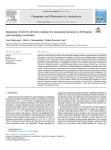Chukwuma U., Gebremedhin K.G., Uyeh D.D. (2024). Imagining AI-driven decision making for managing farming in developing and emerging economies. Computers and Electronics in Agriculture, 01/06/2024, vol. 221, p. 108946.
https://doi.org/10.1016/j.compag.2024.108946
https://doi.org/10.1016/j.compag.2024.108946
| Titre : | Imagining AI-driven decision making for managing farming in developing and emerging economies (2024) |
| Auteurs : | U. Chukwuma ; K.G. Gebremedhin ; D.D. Uyeh |
| Type de document : | Article |
| Dans : | Computers and Electronics in Agriculture (vol. 221, June 2024) |
| Article en page(s) : | p. 108946 |
| Langues : | Anglais |
| Langues du résumé : | Anglais |
| Catégories : |
Catégories principales 06 - AGRICULTURE. FORÊTS. PÊCHES ; 6.6 - Technique Agricole (sols, engrais, mécanisation)Thésaurus IAMM AGRICULTURE ; INTELLIGENCE ARTIFICIELLE ; AIDE A LA DECISION ; PRISE DE DECISION ; MEGADONNEES ; PAYS EN DEVELOPPEMENT ; AFRIQUE |
| Résumé : | Agriculture is the backbone of numerous developing and emerging economies, supporting millions of livelihoods and playing a crucial role. The transformative integration of AI-driven tools, big-data analytics, and advanced technologies, such as drones and satellites, can transform agricultural decision-making in these developing and emerging economies and globally. Acknowledging the intricate web of biophysical and socioeconomic factors that influence agricultural systems, we highlight the pressing need for innovative approaches. We explore the critical role of big-data analytics, Computational Fluid Dynamics (CFD), Machine Learning (ML), and remote sensing in transforming the sector, with a focus on enhancing efficiency, sustainability, and productivity. In this context, continuous real-time monitoring becomes essential, allowing farmers to manage their agricultural systems with precision. Implementing AI-driven tools and devices enables the collection and analysis of data in real time, leading to timely decisions that can significantly improve crop yields and resource management. This study discusses the impacts of big-data analytics on agriculture, including reduced pesticide use and improved crop yields. It presents concrete examples of AI applications in crop and animal farming, emphasizing precision irrigation, fertilizer management, animal health monitoring, and reproductive efficiency. We advocate for customizing these technologies to suit local contexts, which can lead to ensuring deep integration into developing and emerging economies' agricultural practices. In conclusion, the paper calls for collaborative efforts from governments, the private sector, and educational institutions to make these technologies accessible, affordable, and culturally relevant. |
| Cote : | Réservé lecteur CIHEAM |
| URL / DOI : | https://doi.org/10.1016/j.compag.2024.108946 |







